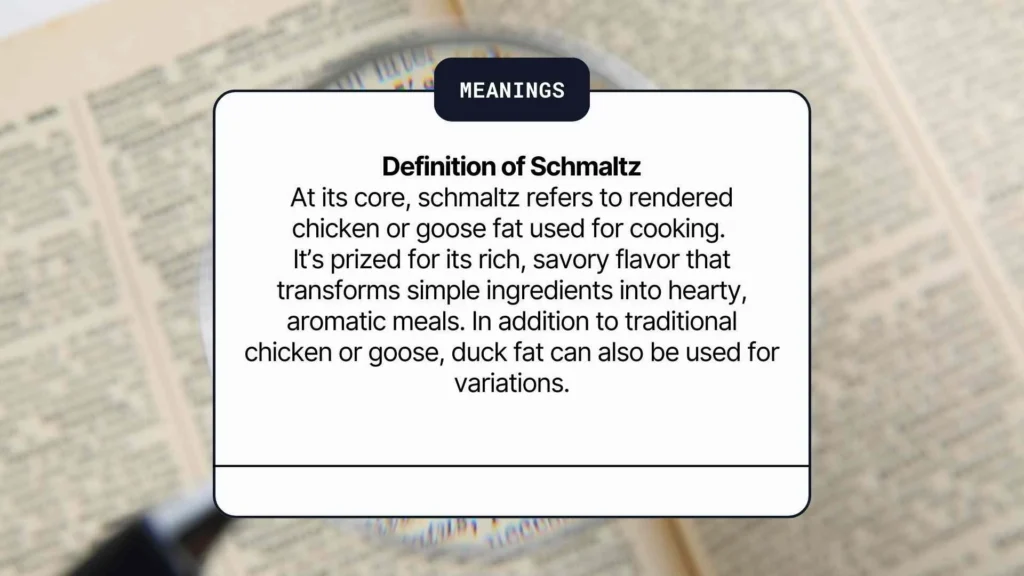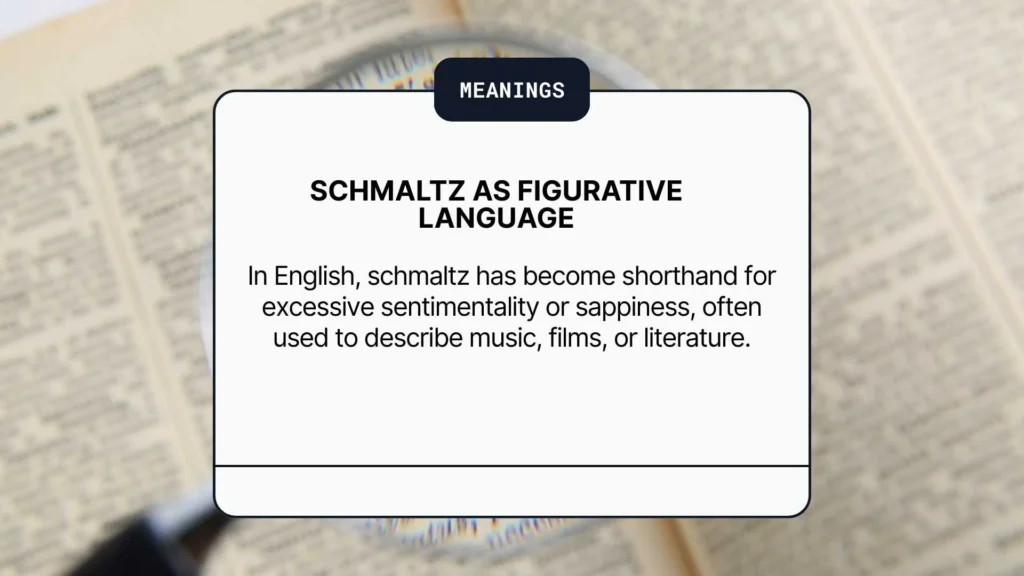Schmaltz is a word that carries layers of meaning—literally and figuratively.
Whether you’re talking about rendered chicken fat in a traditional Ashkenazi kitchen or describing a movie scene
that’s a little too sentimental, schmaltz has left its mark on culinary and cultural language alike.
In this guide, we’ll explore its culinary, figurative, and emotional significance, tracing its origins and showing how it remains relevant today.
What Is Schmaltz? Understanding the Culinary Meaning

Schmaltz in the kitchen is more than just a cooking fat—it’s a flavor enhancer steeped in tradition. It forms the backbone of many iconic Jewish dishes and has even influenced modern gastronomy.
Definition of Schmaltz
At its core, schmaltz refers to rendered chicken or goose fat used for cooking.
It’s prized for its rich, savory flavor that transforms simple ingredients into hearty, aromatic meals. In addition to traditional chicken or goose, duck fat can also be used for variations.
Key uses include:
- Matzo balls in chicken soup
- Potato latkes during Hanukkah
- Kasha varnishkes (buckwheat with bowtie pasta)
- Chopped liver
The fat isn’t just for taste; it’s central to achieving authentic texture and aroma.
Types of Schmaltz
Different types of schmaltz exist, each with a distinct flavor profile:
- Chicken fat: Mild, versatile, and commonly used in Ashkenazi cooking.
- Goose fat: Richer, with a slightly stronger flavor.
- Duck fat: Luxurious and increasingly popular in gourmet cooking.
- Vegetarian alternatives: Olive oil, coconut oil, or plant-based fats for those avoiding animal products.
Each type offers unique ways to enhance flavors while maintaining culinary tradition.
Traditional Dishes Using Schmaltz
Some classic Jewish dishes rely on schmaltz for authentic taste:
- Gribenes: Crispy bits of skin and fat from rendered chicken, often served as a snack.
- Matzo balls: Light, fluffy dumplings in chicken soup.
- Kasha varnishkes: Buckwheat and pasta combination sautéed in schmaltz.
- Chopped liver: Ground liver mixed with onions and schmaltz.
- Potato latkes: Fried potato pancakes, especially during Hanukkah.
These dishes remain staples in Jewish homes and are also featured in modern restaurant menus focusing on artisanal, traditional foods.
Cooking Techniques
Rendering schmaltz is a straightforward but important process:
- Chop fatty pieces of chicken or goose skin.
- Slowly cook over low heat, letting the fat melt.
- Strain to separate the crispy bits (gribenes) from the liquid fat.
- Store in jars in the fridge for later use.
Flavor tip: Sauté onions in schmaltz to add depth and umami to any dish.
Nutritional Aspects
While delicious, schmaltz is high in calories and saturated fat. One tablespoon of chicken schmaltz contains roughly 115 calories and 13 grams of fat, which is why moderation is recommended. Vegetarian alternatives like olive oil can reduce fat intake while maintaining flavor.
The Etymology and Linguistic Journey of Schmaltz
The story of schmaltz extends far beyond the kitchen, tracing a fascinating journey through languages and cultures.
Yiddish and German Origins
Schmaltz comes from Yiddish “shmaltz”, itself derived from the German word “Schmalz”, meaning fat. Historically, it referred to the rendered fat used in Ashkenazi Jewish households across Eastern Europe.
Adoption into English
Jewish immigrants brought schmaltz to America in the early 20th century. Over time, the word migrated from literal fat to figurative sentimentality, and today it’s commonly used in American slang.
Pronunciation
Schmaltz is pronounced /ʃmɔːlts/. Some regional variations exist, but the Yiddish origin remains the root for both culinary and figurative uses.
Evolution of Meaning
Originally, schmaltz described literal fat. By the mid-1900s, it also referred to over-sentimentality, appearing in literature, films, and everyday conversation. This evolution shows how words adapt across cultures and generations.
Modern Dictionaries and Sources
Authoritative references include:
- Merriam-Webster Dictionary
- Oxford English Dictionary
- Jewish Virtual Library
- Serious Eats (culinary insights)
These sources confirm both the culinary and figurative meanings of schmaltz.
Schmaltz as Figurative Language

In English, schmaltz has become shorthand for excessive sentimentality or sappiness, often used to describe music, films, or literature.
Figurative Meaning
When someone says a movie or greeting card is “too schmaltzy,” they mean it’s overly emotional or sentimental—sometimes to the point of humor.
Emotional & Literary Use
Writers and critics often highlight schmaltz in literature and media:
- Toni Morrison has noted in critiques how excessive sentiment can overshadow substance.
- Romantic comedies and greeting cards frequently employ schmaltz to evoke nostalgia or warmth.
It’s a delicate balance: enough emotion to touch the audience, but not so much that it feels overdone.
Cultural Connotations
Schmaltz is closely linked to humor, nostalgia, and tradition. In American pop culture, it often appears with irony or affectionate exaggeration, reflecting Jewish immigrant identity and cultural humor.
Common Expressions
Some idiomatic uses include:
- “The film was sweet, but a bit schmaltzy.”
- “Her speech had just the right amount of schmaltz to be moving, not cloying.”
Critiques and Appreciation
While some see schmaltz as excessive, others appreciate it for adding emotional depth and nostalgic warmth. It’s a tool for both literary critique and everyday conversation.
Cultural Significance of Schmaltz
Beyond food and language, schmaltz embodies heritage, identity, and cultural memory.
Jewish Cooking Tradition
For generations, schmaltz has been central to Ashkenazi Jewish cuisine, linking families through shared recipes and rituals. Holiday meals like Hanukkah or Passover often feature matzo balls, potato latkes, and chopped liver made with rendered schmaltz.
Immigrant Identity
For Jewish immigrants in America, schmaltz symbolized home and continuity. Its flavors evoke memory, comfort, and cultural roots that transcend generations.
Modern Revival
Contemporary chefs are rediscovering schmaltz, featuring it in restaurant menus and artisanal dishes, bridging tradition with gourmet innovation.
Global Influence
Other cuisines use rendered fats like lard, tallow, and duck fat, but the cultural and emotional resonance of schmaltz remains uniquely Jewish.
Nostalgia and Memory
Whether in a family kitchen or a movie scene, schmaltz carries emotional weight—an edible link to heritage and nostalgia.
Schmaltz in Contemporary Food Culture
Vegetarian and Vegan Alternatives
With growing demand for plant-based diets, olive oil, coconut oil, and plant-based fats provide options without sacrificing flavor. This adaptation keeps traditional dishes accessible to more people.
Flavor Enhancement
Schmaltz is more than fat—it’s a flavor enhancer. It elevates onions, garlic, and herbs, bringing richness to simple ingredients.
Health Considerations
While flavorful, it’s high in saturated fat and calories. Moderation or substitution with plant-based oils balances health with tradition.
Culinary Trends
Chefs now use schmaltz in artisanal breads, fusion dishes, and gourmet presentations, demonstrating its timeless appeal.
Comparative Uses
| Fat Type | Flavor Profile | Best Use |
| Chicken Schmaltz | Mild, savory | Matzo balls, chopped liver |
| Goose Fat | Rich, strong | Roasted vegetables, latkes |
| Duck Fat | Luxurious | Gourmet dishes, French fries |
| Olive Oil | Mild, healthy | Vegetarian alternatives |
How to Use Schmaltz Today
Cooking Tips
- Store schmaltz in airtight jars in the fridge.
- Use rendered fat for sautéing, roasting, and flavoring soups.
- Keep gribenes for snacks or salad toppings.
Recipes to Try
- Matzo balls in chicken soup
- Potato latkes with applesauce
- Kasha varnishkes with onions
- Chopped liver
These recipes maintain culinary tradition while allowing flexibility for modern tastes.
Flavor Pairings
- Onions, garlic, herbs, mushrooms, or roasted vegetables.
- Balances richness with subtle aromatics to avoid overwhelming dishes.
Incorporating Figurative Schmaltz
When writing or speaking, add emotional warmth but avoid going overboard. A little schmaltz can connect with the audience; too much can feel cloying.
Keeping Tradition Alive
- Use authentic ingredients and techniques.
- Adapt recipes to dietary needs without losing cultural essence.
- Share stories behind the dishes to preserve heritage and nostalgia.
Quick Reference Table
| Term | Meaning | Usage | Alternative |
| Schmaltz | Rendered fat | Cooking | Olive oil, duck fat |
| Schmaltzy | Over-sentimental | Figurative | Heartwarming (less overdone) |
| Gribenes | Crispy bits from fat | Snack | – |
| Matzo balls | Dumplings in soup | Meal | – |
| Kasha varnishkes | Buckwheat & pasta dish | Meal | Vegetarian adaptation |
Schmaltz is a word and concept that transcends the kitchen. It’s a culinary staple, a figurative expression of sentiment, and a cultural emblem.
From rendered chicken fat to heartwarming movies and greeting cards, it carries flavor, emotion, and memory.
Understanding schmaltz allows us to appreciate Jewish culinary traditions, navigate figurative language, and savor both taste and sentiment.
Conclusion
Schmaltz is much more than a cooking fat—it’s a bridge between tradition, culture, and language.
From the rich flavors of matzo balls, potato latkes, and chopped liver to its figurative use describing over-sentimentality in literature and media, it carries both culinary and emotional weight.
Its Yiddish roots and journey into English slang highlight the resilience of cultural identity, while modern adaptations—like vegetarian schmaltz—ensure its relevance today.
By understanding schmaltz, you not only savor a unique flavor but also appreciate the stories, heritage, and sentiment woven into every dish and expression.
Whether in the kitchen or in language, schmaltz connects the past and present, taste and emotion, tradition and creativity.

Michael Smith is the creator of PikupLab.com, known for crafting engaging, SEO-smart content that connects with modern audiences.
He specializes in turning niche topics into high-ranking, reader-focused articles.

